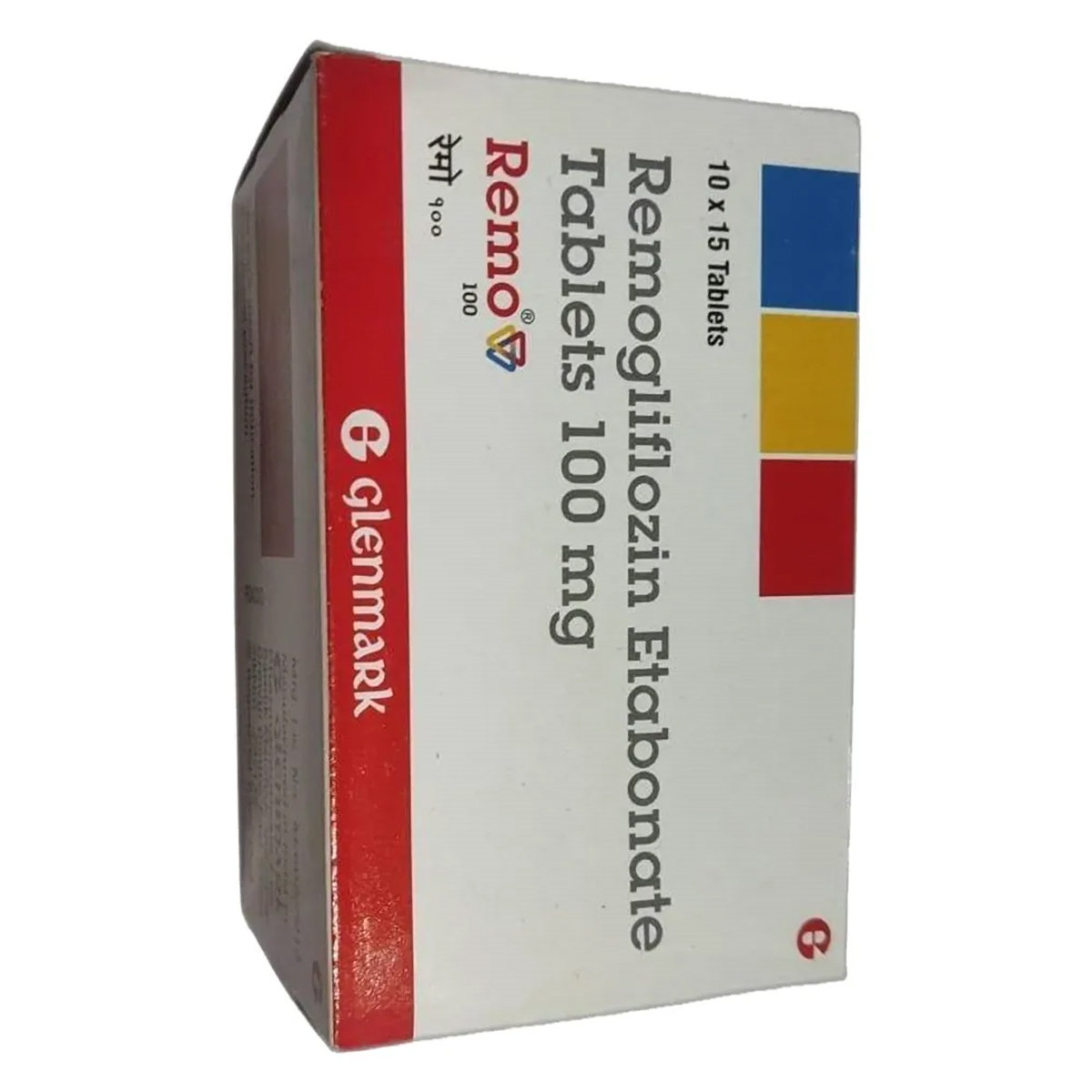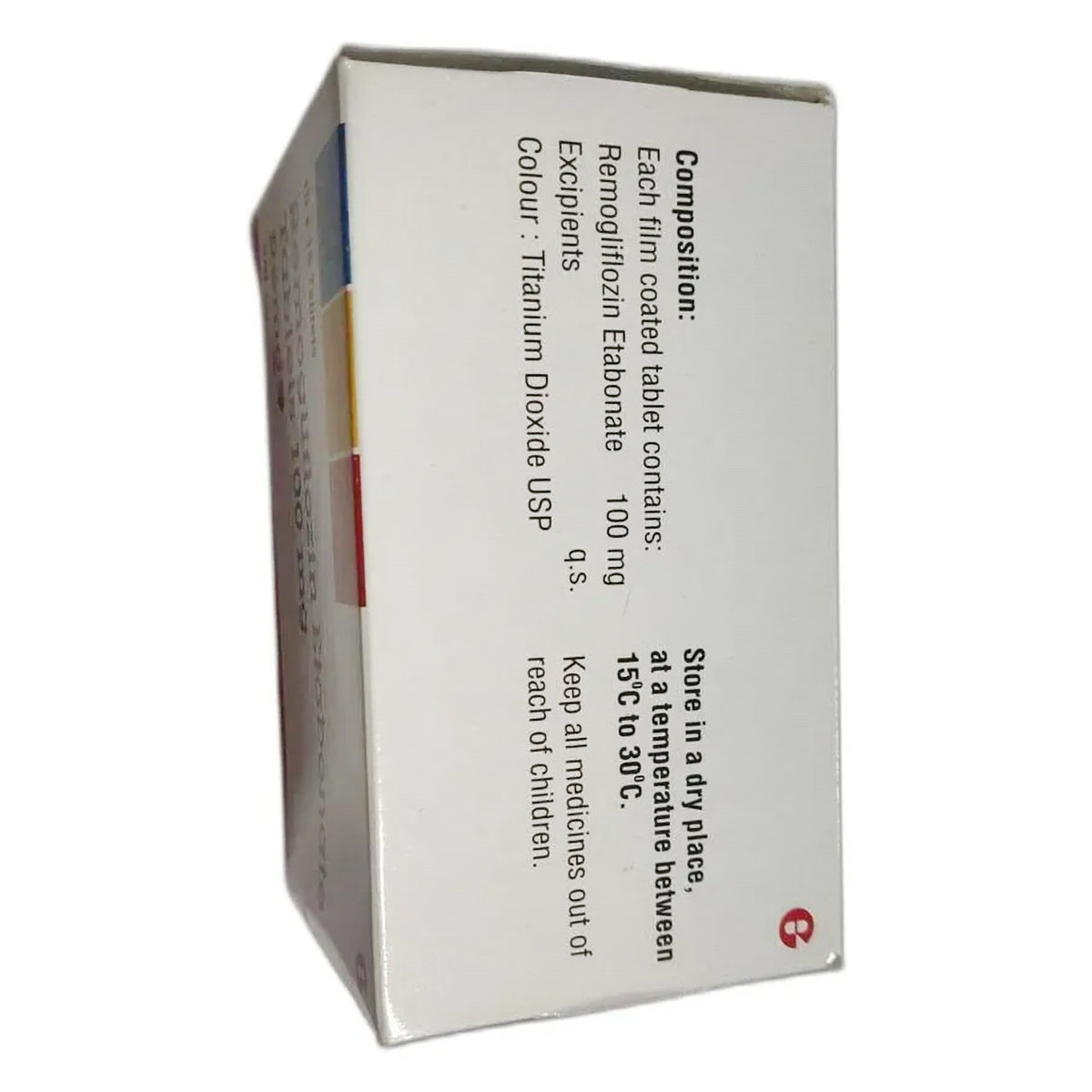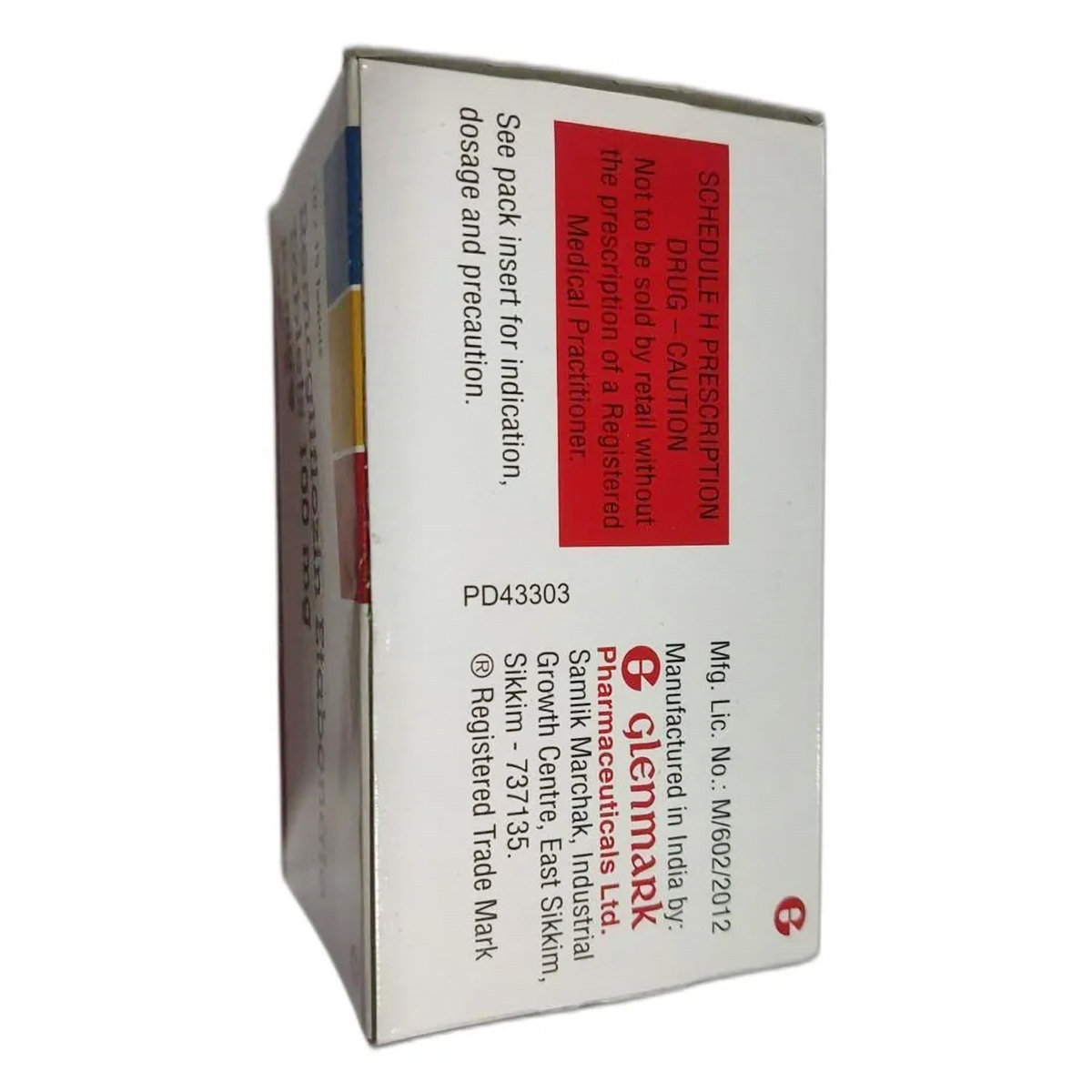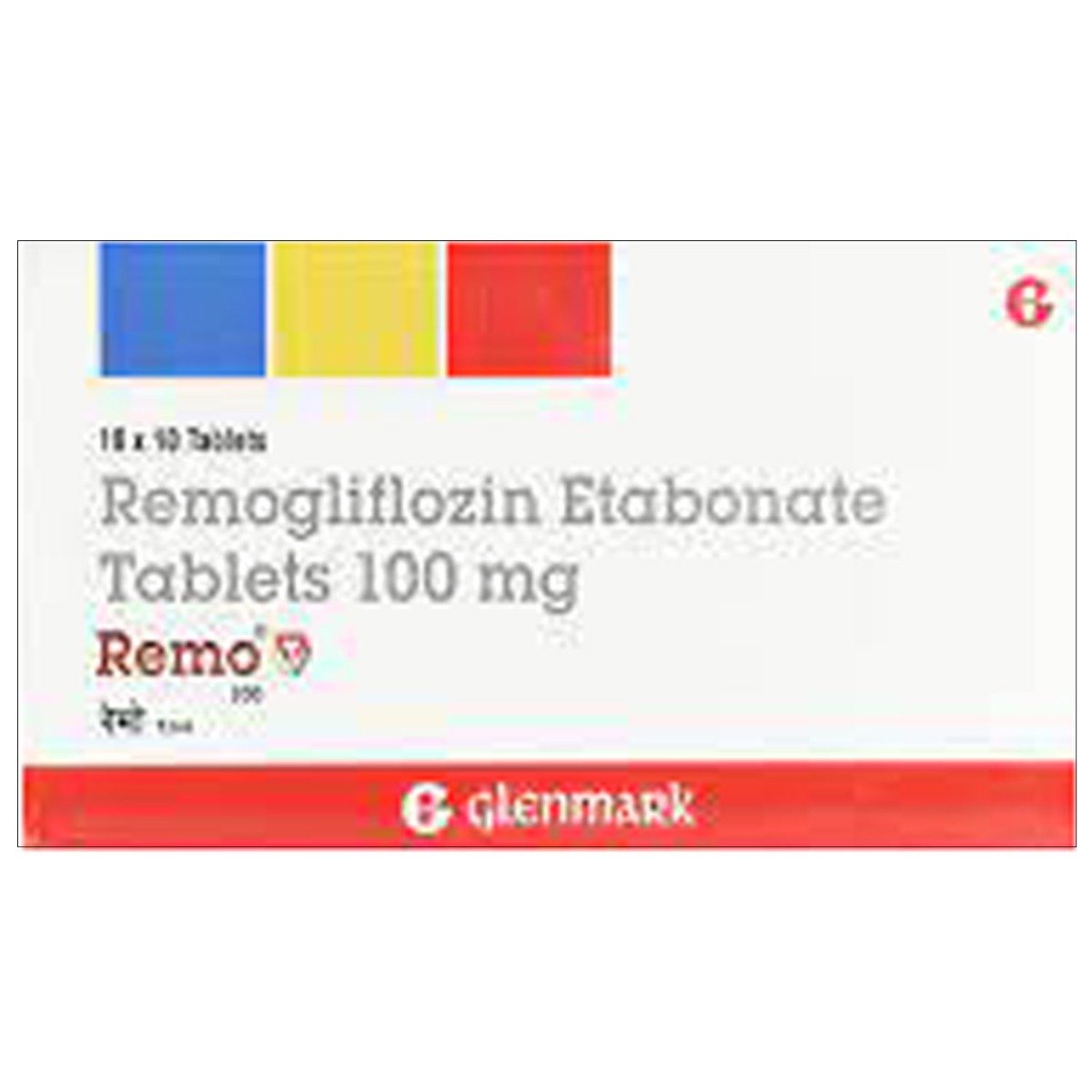Remo 100 mg Tablet 15's






MRP ₹220
(Inclusive of all Taxes)
₹33.0 Cashback (15%)
Selected Pack Size:15
15 ₹198
(₹13.2 per unit)
In Stock
10 ₹128.7
(₹12.87 per unit)
Out of stock
Provide Delivery Location
Online payment accepted
 Prescription drug
Prescription drugWhats That
Composition :
Manufacturer/Marketer :
Consume Type :
Return Policy :
Expires on or after :
About Remo 100 Tablet
Remo 100 Tablet belongs to the class of antidiabetic drugs, primarily used to treat type 2 diabetes mellitus and non-alcoholic steatohepatitis (non-alcoholic fatty liver disease). Diabetes mellitus is a metabolic disease that causes high blood sugar levels. It occurs when the insulin (a hormone produced by the beta cells of the pancreas) is resistant in breaking the glucose to produce energy (insulin resistance) or the pancreas (an organ behind the stomach) produce little or no insulin at all. Remo 100 Tablet is not indicated for use in type 1 diabetes.
Remo 100 Tablet contains Remogliflozin Etabonate. It belongs to the class of gliflozins. It is a sodium-glucose transporter 2 inhibitor and works by reducing blood sugar levels by eliminating excess sugars from the body through urine. Thus, it helps improve the glycaemic control (control of glucose levels) in patients. Remo 100 Tablet also lowers the risk of heart failure in type 2 diabetic patients with heart diseases.
Take Remo 100 Tablet as advised by your doctor. Some common side effects of Remo 100 Tablet include nausea, frequent urge to urinate, low blood sugar levels, fungal infection in the genital area, and increased thirst. These side effects are not familiar to everyone and vary individually. If you notice any side effects that are not manageable, please consult your doctor.
Remo 100 Tablet may cause hypoglycaemia (low blood sugar); hence it advised to take healthy food with enough calories and avoid heavy exercises. Do not take or stop this medicine if the doctor did not advise you to do so. Before starting Remo 100 Tablet , let your doctor know if you have any medical history of heart, kidney or liver diseases, breathing problems, blood disorders, dehydration, alcohol use, low blood pressure, and yeast infection of genitals. It is advised to avoid your alcohol intake while using Remo 100 Tablet . Remo 100 Tablet should be used only when prescribed by a doctor if you are pregnant or breastfeeding.
Uses of Remo 100 Tablet
Directions for Use
Medicinal Benefits
Remo 100 Tablet treats type 2 diabetes mellitus and contains Remogliflozin Etabonate. It works by reducing blood sugar levels by eliminating excess sugars from the body through urine. Remo 100 Tablet also reduces the risk of heart failure in patients with type 2 diabetes and heart disease. Remo 100 Tablet may be advised with or without other medications along with diet and exercise to control blood sugar levels.
Storage
- Inform your doctor about your constipation symptoms. They may adjust your medication or advise alternative treatments.
- Stay hydrated by drinking sufficient of water (at least 8-10 glasses a day) to help soften stool and promote bowel movements.
- Increase fibre intake by eating foods high in fibre, such as fruits, whole grains, vegetables and legumes, to help bulk up the stool.
- Establish a bowel routine by trying to go to the bathroom at the same time each day to train your bowels.
- Engaging in regular exercise, like walking or yoga, can support in bowel movement stimulation.
- Consult your doctor if constipation persists, and discuss alternative treatments or adjustments to your medication.
- Inform Your Doctor: Notify your doctor immediately about your diarrhoea symptoms. This allows them to adjust your medication or provide guidance on managing side effects.
- Stay Hydrated: Drink plenty of fluids to replace lost water and electrolytes. Choose water, clear broth, and electrolyte-rich drinks. Avoid carbonated or caffeinated beverages to effectively rehydrate your body.
- Follow a Bland Diet: Eat easy-to-digest foods to help firm up your stool and settle your stomach. Try incorporating bananas, rice, applesauce, toast, plain crackers, and boiled vegetables into your diet.
- Avoid Trigger Foods: Steer clear of foods that can worsen diarrhoea, such as spicy, fatty, or greasy foods, high-fibre foods, and dairy products (especially if you're lactose intolerant).
- Practice Good Hygiene: Maintain good hygiene to prevent the spread of infection. To stay healthy, wash your hands frequently, clean and disinfect surfaces regularly, and avoid exchanging personal belongings with others.
- Take Anti-Diarrheal Medications: If your doctor advises, anti-diarrheal medications such as loperamide might help manage diarrhoea symptoms. Always follow your doctor's directions.
- Keep track of your diarrhoea symptoms. If they don't get better or worse or are accompanied by severe stomach pain, blood, or dehydration signs (like extreme thirst or dark urine), seek medical help.
- Rest well; get enough sleep.
- Eat a balanced diet and drink enough water.
- Manage stress with yoga and meditation.
- Limit alcohol and caffeine.
- Physical activities like walking or jogging might help boost energy and make you feel less tired.
- Changes in kidney function need immediate medical attention.
- Always monitor your blood pressure and inform your healthcare team if there are any sudden changes.
- Take medicines as prescribed and eat a balanced diet suggested by your dietician for healthy kidney function.
- Physical activity and exercise must be included in your daily routine to have proper kidney functioning and to maintain a healthy weight.
- Get enough sleep to reduce the stress levels that have a direct impact on your kidney functioning.
- Tell your doctor about the cough symptoms you're experiencing, which may be triggered by your medication.
- Your doctor may adjust your treatment plan by changing your medication, adding new medications, or providing guidance on managing your cough symptoms.
- Practice good hygiene, including frequent handwashing, avoiding close contact with others, and avoiding sharing utensils or personal items.
- Stay hydrated by drinking plenty of fluids, such as water, tea, or soup, to help thin out mucus and soothe your throat.
- Get plenty of rest and engage in stress-reducing activities to help your body recover. If your cough persists or worsens, consult your doctor for further guidance.
Drug Warnings
Inform your doctor if you take other antidiabetic drugs to adjust the dosage of Remo 100 Tablet accordingly. Do not abruptly stop taking Remo 100 Tablet midway if the doctor did not advise you. Remo 100 Tablet may cause hypoglycaemia (low blood sugar); hence it is advised to take healthy food with enough calories and avoid heavy exercises. Brief your medical history to doctor if you have any heart, kidney or liver diseases, breathing problems (asthma, obstructive lung diseases), blood problems like anaemia (lack of blood cells), vitamin B12 deficiency, pancreas problems/surgery, dehydration, alcohol use, low blood pressure, and genital yeast infection before taking Remo 100 Tablet . Remo 100 Tablet should be used only when prescribed by a doctor if you are pregnant or breastfeeding. Your doctor may advise alternate medications to control your diabetic condition in such cases.
Drug-Drug Interactions
Drug-Drug Interactions
Login/Sign Up
Drug-Food Interactions
Drug-Food Interactions
Login/Sign Up
Diet & Lifestyle Advise
- Include Vitamin B1-rich foods like beans, legumes, dairy products (such as yoghurt), eggs, meat, poultry, fish, nuts, seeds, thiamine-enriched breakfast cereals, and whole grains in your diet
- Maintain a fibre-rich diet and include healthy carbohydrates from fruits, vegetables and whole grains to maintain your blood glucose levels.
- Eat at regular intervals.
- Keep a check on your weight and exercise regularly to keep your heart healthy.
- Your doctor also guides you on noticing and managing the early symptoms of high/low blood sugar levels.
- Gastrointestinal side effects can be managed with simple modifications in your lifestyle. These include cutting down on sugars and fatty foods, and avoiding carbonated drinks and foods that cause gas.
Side Effects of Remo 100 Tablet
- Nausea
- Frequent urge to urinate
- Low blood sugar levels
- Fungal infection in the genital area
- Increased thirst
Habit Forming
Therapeutic Class
All Substitutes & Brand Comparisons
RX
Reniva 100 Tablet 10's
Intas Pharmaceuticals Ltd
₹128
(₹11.52 per unit)
12% CHEAPERRX
Out of StockRefozid 100mg Tablet
₹133
(₹11.97 per unit)
9% CHEAPERRX
Out of StockRemo 100 mg Tablet 10's
Glenmark Pharmaceuticals Ltd
₹143
(₹12.87 per unit)
2% CHEAPER
Product Substitutes
Author Details
We provide you with authentic, trustworthy and relevant information
Drug-Diseases Interactions
Drug-Diseases Interactions
Login/Sign Up
FAQs
Remo 100 Tablet contains an antidiabetic medicine, Remogliflozin Etabonate. It lowers the blood sugar levels in type 2 diabetes mellitus by eliminating excess sugars through urine and thus helps in glycaemic control in diabetic patients.
Remo 100 Tablet may cause low blood sugar levels (hypoglycaemia) and can make you hungry, dizzy, irritable, confused, anxious, or shaky. Hence, it is advised to take Remo 100 Tablet with a meal. To immediately treat hypoglycaemia, it is advised to eat or drink fast-acting sugar sources like fruit juices, hard candy, raisins, or non-diet soda.
Your doctor may advise Remo 100 Tablet with or without other medications to control your blood sugar levels. However, it is advised to maintain a proper diet and exercise to achieve the controlled blood sugar levels while using Remo 100 Tablet with or without other antidiabetic drugs.
Remo 100 Tablet should be used with caution in heart, kidney or liver diseases, breathing problems (asthma, obstructive lung disease), blood disorders (anaemia, vitamin B12 deficiency), dehydration, alcohol use, low blood pressure, pancreas problems/surgery, and yeast infection of genitals. Inform your doctor in advance if you have any other medical concerns.
Take the missed dose as soon as possible. However, if it is time for the next dose, skip the missed dose and go back to your regular dosing schedule. Do not double the dose.
Drug-Drug Interactions Checker List
- FLUCONAZOLE
- SILDENAFIL
- GLIMEPIRIDE
- PREGABALIN
Special Advise
- It is advised to monitor your blood sugar levels regularly.
- Regular monitoring of kidney functioning is advised while using Remo 100 Tablet .
Disease/Condition Glossary
Diabetes mellitus, also known as adult-onset diabetes, is a metabolic disease that causes high blood sugar levels. It is type 2 diabetes and occurs when the insulin (a hormone produced by the beta cells of the pancreas) is resistant in breaking the glucose to produce energy (insulin resistance) or the pancreas (an organ behind the stomach) produce little or no insulin at all. This disease mainly occurs in people aged above 40 years but can also occur in childhood based on the risk factors. The treatment includes oral glucose-lowering medicines and insulin shots.

Have a query?
Buy best Diabetics products by
Torrent Pharmaceuticals Ltd
Sun Pharmaceutical Industries Ltd
Eris Life Sciences Ltd
Intas Pharmaceuticals Ltd
Lupin Ltd
Micro Labs Ltd
Mankind Pharma Pvt Ltd
Lloyd Healthcare Pvt Ltd
Alkem Laboratories Ltd
Abbott India Ltd
Glenmark Pharmaceuticals Ltd
Cipla Ltd
Macleods Pharmaceuticals Ltd
Wockhardt Ltd
Dr Reddy's Laboratories Ltd
Primus Remedies Pvt Ltd
USV Pvt Ltd
Aristo Pharmaceuticals Pvt Ltd
Emcure Pharmaceuticals Ltd
Alembic Pharmaceuticals Ltd
Ipca Laboratories Ltd
La Renon Healthcare Pvt Ltd
Ajanta Pharma Ltd
Medley Pharmaceuticals Ltd
East West Pharma India Pvt Ltd
Elbrit Life Sciences Pvt Ltd
Corona Remedies Pvt Ltd
Hbc Life Sciences Pvt Ltd
Sinsan Pharmaceuticals Pvt Ltd
Ranmarc Labs
Mitoch Pharma Pvt Ltd
Zydus Healthcare Ltd
Sanofi India Ltd
Akumentis Healthcare Ltd
Fusion Health Care Pvt Ltd
Unison Pharmaceuticals Pvt Ltd
Jubilant Lifesciences Ltd
Novo Nordisk India Pvt Ltd
Tas Med India Pvt Ltd
Blue Cross Laboratories Pvt Ltd
Msn Laboratories Pvt Ltd
Eswar Therapeutics Pvt Ltd
Indoco Remedies Ltd
Q Check Pharmaceuticals
Alteus Biogenics Pvt Ltd
Anthem Bio Pharma
Franco Indian Pharmaceuticals Pvt Ltd
Systopic Laboratories Pvt Ltd
Panacea Biotec Ltd
Zydus Cadila
Biocon Ltd
Edoc Life Sciences Pvt Ltd
Koye Pharmaceuticals Pvt Ltd
Arkas Pharma Pvt Ltd
Diacardus Pharmacy Pvt Ltd
Elinor Pharmaceuticals (P) Ltd
Remedy Life Sciences Pvt Ltd
Saan Labs
Talent India Pvt Ltd
Jarun Pharmaceuticals Pvt Ltd
Capital Pharma
Shrrishti Health Care Products Pvt Ltd
FDC Ltd
Leeford Healthcare Ltd
Nirvana India Pvt Ltd
Elder Pharmaceuticals Ltd
Eli Lilly and Company (India) Pvt Ltd
Glynis Pharmaceuticals Pvt Ltd
Zuventus Healthcare Ltd
Arrient Healthcare Pvt Ltd
Cadomed Pharmaceuticals India Pvt Ltd
Orris Pharmaceuticals
Akesiss Pharma Pvt Ltd
Bal Pharma Ltd
Biochem Pharmaceutical Industries Ltd
Knoll Healthcare Pvt Ltd
Lippon Pharma Pvt Ltd
Morepen Laboratories Ltd
Neucure Lifesciences Pvt Ltd
Opsis Care Lifesciences Pvt Ltd
Wallace Pharmaceuticals Pvt Ltd
Acmedix Pharma Llp
Converge Biotech Pvt Ltd
Erinyle Pharma
Indiabulls Pharmaceuticals Pvt Ltd
Ozone Pharmaceuticals Ltd
Retra Life Science Pvt Ltd
Alvio Pharmaceuticals Pvt Ltd
Geneaid Pharmaceuticals
Heal (India) Laboratories Pvt Ltd
Olcare Laboratories Pvt Ltd
Vasu Organics Pvt Ltd
Kotak Life Sciences
Lakshya Life Sciences Pvt Ltd
Proqol Health Care Pvt Ltd
Sanz Pharmaceuticals
Daylon healthcare pvt Ltd
Mcronus Lifescience Pvt Ltd
Natco Pharma Ltd
Orsim Pharma
Alcohol
Caution
It is advised to avoid alcohol intake since it may worsen the risk of developing low blood sugar levels.
Pregnancy
Caution
Gliflozins are usually not recommended during the second or third trimester of pregnancy. Your doctor may suggest other medications to control your blood sugar levels. Please consult your doctor before starting Remo 100 Tablet if you are pregnant or planning to conceive.
Breast Feeding
Caution
There is limited information on how Remo 100 Tablet affects breastfeeding. Please seek medical advice for further information.
Driving
Caution
Your driving ability may be affected if your blood sugar levels are too high or too low. Do not drive or operate machinery if you also experience blurred vision, dizziness or drowsiness due to extremely low or high blood sugar.
Liver
Caution
Let your doctor know if you have any history of liver diseases or hepatic impairment when prescribed Remo 100 Tablet . Your doctor will prescribe Remo 100 Tablet only if the benefit outweighs the risk.
Kidney
Caution
Let your doctor know if you have any history of kidney diseases when you are prescribed Remo 100 Tablet . Your doctor will prescribe Remo 100 Tablet only if the benefit outweighs the risk.
Children
Caution
Your child’s doctor will decide whether to give Remo 100 Tablet to children or not.
Recommended for a 30-day course: 2 Strips









